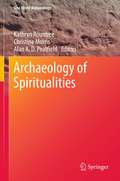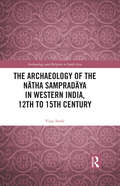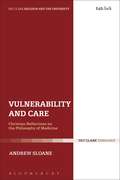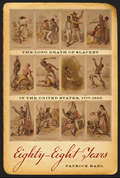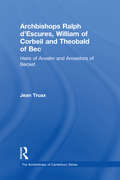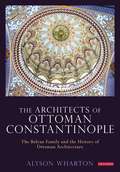- Table View
- List View
Archaeology of Spiritualities (One World Archaeology)
by Kathryn Rountree, Christine Morris and Alan A. D. PeatfieldArchaeology of Spiritualties provides a fresh exploration of the interface between archaeology and religion/spirituality. Archaeological approaches to the study of religion have typically and often unconsciously, drawn on western paradigms, especially Judaeo-Christian (mono) theistic frameworks and academic rationalisations. Archaeologists have rarely reflected on how these approaches have framed and constrained their choices of methodologies, research questions, hypotheses, definitions, interpretations and analyses and have neglected an important dimension of religion: the human experience of the numinous - the power, presence or experience of the supernatural.Within the religions of many of the world’s peoples, sacred experiences – particularly in relation to sacred landscapes and beings connected with those landscapes – are often given greater emphasis, while doctrine and beliefs are relatively less important. Archaeology of Spiritualities asks how such experiences might be discerned in the archaeological record; how do we recognize and investigate ‘other’ forms of religious or spiritual experience in the remains of the past?.The volume opens up a space to explore critically and reflexively the encounter between archaeology and diverse cultural expressions of spirituality. It showcases experiential and experimental methodologies in this area of the discipline, an unconventional approach within the archaeology of religion. Thus Archaeology of Spiritualities offers a unique, timely and innovative contribution, one that is also challenging and stimulating. It is a great resource to archaeologists, historians, religious scholars and others interested in cultural and religious heritage.
The Archaeology of the Nātha Sampradāya in Western India, 12th to 15th Century (Archaeology and Religion in South Asia)
by Vijay SardeThis book studies Nātha sampradāya through archaeological evidence for the first time. Drawing on a pioneering approach to the study of ascetic traditions, it investigates not only the nature of the Nātha sampradāya’s religious architecture but also examines the extent to which they shared space with other religious groups such as the devotees of Siva and Sakti, Buddhism, and Islam, especially with the Sufi tradition. Focusing on western India, the book sifts through a variety of archaeological evidence and documentation of their temples, caves, and maṭhas. It critically analyses iconographic representations of ascetics on temple walls and sculptural representations of yogic postures or āsanas. Further, these representations are discussed within a pan-South Asian framework to highlight both the commonalities of the tradition across the subcontinent and the regional specificities, along with their chronological spread. Breaking new ground, this volume will be of great interest to scholars and researchers of religion, especially Hinduism, history, archaeology, and South Asian studies.
The Archaeology of the Nātha Sampradāya in Western India, 12th to 15th Century (Archaeology and Religion in South Asia)
by Vijay SardeThis book studies Nātha sampradāya through archaeological evidence for the first time. Drawing on a pioneering approach to the study of ascetic traditions, it investigates not only the nature of the Nātha sampradāya’s religious architecture but also examines the extent to which they shared space with other religious groups such as the devotees of Siva and Sakti, Buddhism, and Islam, especially with the Sufi tradition. Focusing on western India, the book sifts through a variety of archaeological evidence and documentation of their temples, caves, and maṭhas. It critically analyses iconographic representations of ascetics on temple walls and sculptural representations of yogic postures or āsanas. Further, these representations are discussed within a pan-South Asian framework to highlight both the commonalities of the tradition across the subcontinent and the regional specificities, along with their chronological spread. Breaking new ground, this volume will be of great interest to scholars and researchers of religion, especially Hinduism, history, archaeology, and South Asian studies.
The Archangel Michael in Africa: History, Cult and Persona
by Ingvild Saelid Gilhus Alexandros Tsakos Marta Camilla WrightThis book takes an interdisciplinary approach in order to understand angels, focusing on Africa and the cult and persona of the Archangel Michael. Traditional methods in the study of religion including philology, papyrology, art and iconography, anthropology, history, and psychology are combined with methodologies deriving from memory studies, graphic design, art education, and semiotics. Chapters explore both historical and contemporary case studies from Coptic Egypt, Nubia, Ethiopia, and South Africa, providing a comparative perspective on the Archangel Michael, alongside 25 images. Innovative in both its methodologies and geographical focus, this book is an important contribution to the study of religion and art, Christianity in Africa, and Coptic studies.
The Archangel Michael in Africa: History, Cult and Persona (Bloomsbury Revelations Ser.)
by Ingvild Saelid Gilhus Alexandros Tsakos Marta Camilla WrightThis book takes an interdisciplinary approach in order to understand angels, focusing on Africa and the cult and persona of the Archangel Michael. Traditional methods in the study of religion including philology, papyrology, art and iconography, anthropology, history, and psychology are combined with methodologies deriving from memory studies, graphic design, art education, and semiotics. Chapters explore both historical and contemporary case studies from Coptic Egypt, Nubia, Ethiopia, and South Africa, providing a comparative perspective on the Archangel Michael. The book contains 25 images, and further images can be found on the book's webpage.Innovative in both its methodologies and geographical focus, this book is an important contribution to the study of religion and art, Christianity in Africa, and Coptic studies.
Archbishop: A novel
by Michele GuinnessFive years from now, the Church of England is on its knees. Yet one woman is making a difference, and when she is appointed Archbishop of Canterbury, anything could happen.Vicky Burnham-Woods is a master of diplomacy, and deeply committed to bringing the church back into the heart of community and cultural life - but not everyone wants a woman at the top, and behind the scenes dark forces are moving.Can the first ever female Archbishop of Canterbury last long enough to achieve her mission?
Archbishop Anselm 1093–1109: Bec Missionary, Canterbury Primate, Patriarch of Another World (The Archbishops of Canterbury Series)
by Sally N. VaughnSt Anselm's archiepiscopal career, 1093-1109, spanned the reigns of two kings: William Rufus and the early years of Henry I. As the second archbishop of Canterbury after the Norman Conquest, Anselm strove to extend the reforms of his teacher and mentor at Bec, and his predecessor at Canterbury, Archbishop Lanfranc. Exploring Anselm's thirty years as Prior and Abbot of the large, rich, Norman monastery of Bec, and teacher in its school, this book notes the wealth of experiences which prepared Anselm for his archiepiscopal career--in particular Bec's missionary attitude toward England. Sally Vaughn examines Anselm's intellectual strengths as a teacher, philosopher and theologian: exploring his highly regarded theological texts, including his popular Prayers and Meditations, and how his statesmanship was influenced as he dealt with conflict with the antagonistic King William Rufus. Vaughn argues that Rufus's death influenced Anselm's rivalry with King Henry I and fostered a more subdued and civil conflict between Anselm and Henry which ended with cooperation between king and archbishop at the end of Anselm's life. King and archbishop became’yoked together as two oxen pulling the plow of the church through the land of England’. Anselm’s final years at the pinnacle of power reveal a superb administrator over Canterbury and Primate over the churches of all Britain, in which position his followers described him as 'Pope of another world'. The final section includes a selection of original source material including archiepiscopal letters drawn primarily from Lambeth Palace Library.
Archbishop Anselm 1093–1109: Bec Missionary, Canterbury Primate, Patriarch of Another World (The Archbishops of Canterbury Series)
by Sally N. VaughnSt Anselm's archiepiscopal career, 1093-1109, spanned the reigns of two kings: William Rufus and the early years of Henry I. As the second archbishop of Canterbury after the Norman Conquest, Anselm strove to extend the reforms of his teacher and mentor at Bec, and his predecessor at Canterbury, Archbishop Lanfranc. Exploring Anselm's thirty years as Prior and Abbot of the large, rich, Norman monastery of Bec, and teacher in its school, this book notes the wealth of experiences which prepared Anselm for his archiepiscopal career--in particular Bec's missionary attitude toward England. Sally Vaughn examines Anselm's intellectual strengths as a teacher, philosopher and theologian: exploring his highly regarded theological texts, including his popular Prayers and Meditations, and how his statesmanship was influenced as he dealt with conflict with the antagonistic King William Rufus. Vaughn argues that Rufus's death influenced Anselm's rivalry with King Henry I and fostered a more subdued and civil conflict between Anselm and Henry which ended with cooperation between king and archbishop at the end of Anselm's life. King and archbishop became’yoked together as two oxen pulling the plow of the church through the land of England’. Anselm’s final years at the pinnacle of power reveal a superb administrator over Canterbury and Primate over the churches of all Britain, in which position his followers described him as 'Pope of another world'. The final section includes a selection of original source material including archiepiscopal letters drawn primarily from Lambeth Palace Library.
Archbishop Fisher, 1945–1961: Church, State and World (The Archbishops of Canterbury Series)
by Andrew Chandler David HeinArchbishop Fisher’s archiepiscopate reflected the central issues of his time and place. It was Fisher who oversaw an immense programme of reforms which effectively recast the institutions of the Church of England for generations to come. It was Fisher who proved to be the essential architect, politician and diplomat behind the creation of a worldwide Anglican Communion. His determination to promote the development of relations with other churches produced a vital contribution to the cause of ecumenism, which culminated in his momentous meeting with Pope John XXIII. Archbishop Fisher was a vigorous participant in the questions which defined national and international life. This book explores Fisher’s influence on major contemporary issues and events, including divorce-law reform and capital punishment at home and the end of Empire and the most dangerous years of the Cold War abroad. This new biography establishes the continuing significance not only of the office of Archbishop in the Church but also of the Church at large in the tumultuous world of the later twentieth century. A final section of original source material includes letters, sermons and other writings bringing vividly to life the range and character of Fisher's public and private role.
Archbishop Fisher, 1945–1961: Church, State and World (The Archbishops of Canterbury Series)
by Andrew Chandler David HeinArchbishop Fisher’s archiepiscopate reflected the central issues of his time and place. It was Fisher who oversaw an immense programme of reforms which effectively recast the institutions of the Church of England for generations to come. It was Fisher who proved to be the essential architect, politician and diplomat behind the creation of a worldwide Anglican Communion. His determination to promote the development of relations with other churches produced a vital contribution to the cause of ecumenism, which culminated in his momentous meeting with Pope John XXIII. Archbishop Fisher was a vigorous participant in the questions which defined national and international life. This book explores Fisher’s influence on major contemporary issues and events, including divorce-law reform and capital punishment at home and the end of Empire and the most dangerous years of the Cold War abroad. This new biography establishes the continuing significance not only of the office of Archbishop in the Church but also of the Church at large in the tumultuous world of the later twentieth century. A final section of original source material includes letters, sermons and other writings bringing vividly to life the range and character of Fisher's public and private role.
Archbishop Howley, 1828-1848 (The Archbishops of Canterbury Series)
by James GarrardWilliam Howley, Archbishop of Canterbury 1828-1848, led the Church of England during the beginning and expansion of the Oxford Movement, at a time when the precursor to the Church Commissioners was established, and during the momentous debates and decisions in Parliament which saw the final retreat from the myth of an all Anglican legislature. Howley’s chairmanship of the commissions of the 1830s and 1840s which began the gargantuan task of reforming the Church’s practices and re-arranging its finances, made him an object of fury and scorn to some of those who benefited from things as they were, most especially in the cathedrals. Exploring the central events and debates within the Church of England in the first half of the nineteenth century, this book draws on primary and secondary evidence about Howley’s career and influence. A section of original sources, including his Charges and other public documents, correspondence and speeches in the House of Lords, places Howley’s achievements in proper context and illustrates his prevailing concerns in education, the establishment and political reform, relationships with the Tractarians, and in the early stages of Church reform. Dealing thematically with many of the issues faced by Howley, and exploring his own High Church theological views in historical context, James Garrard offers a fruitful re-appraisal of the intellectual, spiritual and ’party’ context in which Howley moved.
Archbishop Howley, 1828-1848 (The Archbishops of Canterbury Series)
by James GarrardWilliam Howley, Archbishop of Canterbury 1828-1848, led the Church of England during the beginning and expansion of the Oxford Movement, at a time when the precursor to the Church Commissioners was established, and during the momentous debates and decisions in Parliament which saw the final retreat from the myth of an all Anglican legislature. Howley’s chairmanship of the commissions of the 1830s and 1840s which began the gargantuan task of reforming the Church’s practices and re-arranging its finances, made him an object of fury and scorn to some of those who benefited from things as they were, most especially in the cathedrals. Exploring the central events and debates within the Church of England in the first half of the nineteenth century, this book draws on primary and secondary evidence about Howley’s career and influence. A section of original sources, including his Charges and other public documents, correspondence and speeches in the House of Lords, places Howley’s achievements in proper context and illustrates his prevailing concerns in education, the establishment and political reform, relationships with the Tractarians, and in the early stages of Church reform. Dealing thematically with many of the issues faced by Howley, and exploring his own High Church theological views in historical context, James Garrard offers a fruitful re-appraisal of the intellectual, spiritual and ’party’ context in which Howley moved.
Archbishop Pole (The Archbishops of Canterbury Series)
by John EdwardsThis fresh exploration of the life, work and writing of Archbishop Pole, focuses particularly on Pole’s final years (1556-58) as Archbishop of Canterbury. Fully integrating Pole’s English and Continental European experiences, John Edwards places these in their historical context and signposts lessons for contemporary issues and concerns. Stressing the events and character of Pole's 'English' life, up to his exile in the 1530s, as well as in his final years in England (1554-58), this book explores his close relationship, both genealogical and emotional, with Henry VIII and Mary I. Portraying Pole as a crucial figure in the Catholic-Protestant division, which still affects Britain today, this book details the first, and so far last, attempt to restore Roman Catholicism as the 'national religion' of England and Wales by telling the life-story of the hinge figure in forging English religious and political identity for several centuries. The final section of this book draws together important and illuminating source material written by Pole during his years as Archbishop of Canterbury.
Archbishop Pole (The Archbishops of Canterbury Series)
by John EdwardsThis fresh exploration of the life, work and writing of Archbishop Pole, focuses particularly on Pole’s final years (1556-58) as Archbishop of Canterbury. Fully integrating Pole’s English and Continental European experiences, John Edwards places these in their historical context and signposts lessons for contemporary issues and concerns. Stressing the events and character of Pole's 'English' life, up to his exile in the 1530s, as well as in his final years in England (1554-58), this book explores his close relationship, both genealogical and emotional, with Henry VIII and Mary I. Portraying Pole as a crucial figure in the Catholic-Protestant division, which still affects Britain today, this book details the first, and so far last, attempt to restore Roman Catholicism as the 'national religion' of England and Wales by telling the life-story of the hinge figure in forging English religious and political identity for several centuries. The final section of this book draws together important and illuminating source material written by Pole during his years as Archbishop of Canterbury.
Archbishop Ramsey: The Shape of the Church (The Archbishops of Canterbury Series)
by Peter WebsterArchbishop Michael Ramsey’s archiepiscopate from 1961 to 1974 saw profound renegotiations of the relationship of the Church of England with its own flock, with the nation more widely, with the Anglican church worldwide, and with the other Christian churches. Drawing from unique source material in the Lambeth Palace Library archives and reproducing many original writings of Ramsey for the first time, this book explores key questions which surround Ramsey’s tenure. How did Ramsey react to the rapid hollowing-out of the regular constituency of the church whilst at the same time seeing sweeping changes in the manner in which the church tried to minister to those members? What was his role in the widening of the church's global vision, and the growing porousness of its borders with other denominations? And how did the nature of the role of archbishop as figurehead change in this period?
Archbishop Ramsey: The Shape of the Church (The Archbishops of Canterbury Series)
by Peter WebsterArchbishop Michael Ramsey’s archiepiscopate from 1961 to 1974 saw profound renegotiations of the relationship of the Church of England with its own flock, with the nation more widely, with the Anglican church worldwide, and with the other Christian churches. Drawing from unique source material in the Lambeth Palace Library archives and reproducing many original writings of Ramsey for the first time, this book explores key questions which surround Ramsey’s tenure. How did Ramsey react to the rapid hollowing-out of the regular constituency of the church whilst at the same time seeing sweeping changes in the manner in which the church tried to minister to those members? What was his role in the widening of the church's global vision, and the growing porousness of its borders with other denominations? And how did the nature of the role of archbishop as figurehead change in this period?
Archbishop Randall Davidson (The Archbishops of Canterbury Series)
by Michael HughesRandall Davidson was Archbishop of Canterbury for quarter of a century. Davidson was a product of the Victorian ecclesiastical and social establishment, whose advance through the Church was dependent on the patronage of Queen Victoria, but he became Archbishop at a time of huge social and political change. He guided the Church of England through the turbulence of the Edwardian period, when it faced considerable challenges to its status as the established Church, as well as helping shape its response to the horrors of the First World War. Davidson inherited a Church of England that was sharply divided on a range of issues, and he devoted his career as Archbishop to securing its unity, whilst ensuring that its voice continued to be heard both nationally and internationally. A modest and pragmatic man, he was widely respected both within the Church of England and beyond, helping to find solutions to a range of political and ecclesiastical problems. This book explores Davidson’s role within the Church and in the life of Britain more broadly during his time at Canterbury. It includes a large selection of documents that help to reveal the Archbishop’s character and cast light on the way in which he carried out his varied and demanding duties.
Archbishop Randall Davidson (The Archbishops of Canterbury Series)
by Michael HughesRandall Davidson was Archbishop of Canterbury for quarter of a century. Davidson was a product of the Victorian ecclesiastical and social establishment, whose advance through the Church was dependent on the patronage of Queen Victoria, but he became Archbishop at a time of huge social and political change. He guided the Church of England through the turbulence of the Edwardian period, when it faced considerable challenges to its status as the established Church, as well as helping shape its response to the horrors of the First World War. Davidson inherited a Church of England that was sharply divided on a range of issues, and he devoted his career as Archbishop to securing its unity, whilst ensuring that its voice continued to be heard both nationally and internationally. A modest and pragmatic man, he was widely respected both within the Church of England and beyond, helping to find solutions to a range of political and ecclesiastical problems. This book explores Davidson’s role within the Church and in the life of Britain more broadly during his time at Canterbury. It includes a large selection of documents that help to reveal the Archbishop’s character and cast light on the way in which he carried out his varied and demanding duties.
Archbishops Ralph d'Escures, William of Corbeil and Theobald of Bec: Heirs of Anselm and Ancestors of Becket (The Archbishops of Canterbury Series)
by Jean TruaxThe first two archbishops of Canterbury after the Norman Conquest, Lanfranc and Anselm, were towering figures in the medieval church and the sixth archbishop, the martyred Thomas Becket, is perhaps the most famous figure ever to hold the office. In between these giants of the ecclesiastical world came three less noteworthy men: Ralph d'Escures, William of Corbeil, and Theobald of Bec. Jean Truax's volume in the Ashgate Archbishops of Canterbury Series uniquely examines the pontificates of these three minor archbishops. Presenting their biographies, careers, thought and works as a unified period, Truax highlights crucial developments in the English church during the period of the pontificates of these three archbishops, from the death of Anselm to Becket. The resurgent power of the papacy, a changed relationship between church and state and the expansion of archiepiscopal scope and power ensured that in 1162 Becket faced a very different world from the one that Anselm had left in 1109. Selected correspondence, newly translated chronicle accounts and the text and a discussion of the Canterbury forgeries complete the volume.
Archbishops Ralph d'Escures, William of Corbeil and Theobald of Bec: Heirs of Anselm and Ancestors of Becket (The Archbishops of Canterbury Series)
by Jean TruaxThe first two archbishops of Canterbury after the Norman Conquest, Lanfranc and Anselm, were towering figures in the medieval church and the sixth archbishop, the martyred Thomas Becket, is perhaps the most famous figure ever to hold the office. In between these giants of the ecclesiastical world came three less noteworthy men: Ralph d'Escures, William of Corbeil, and Theobald of Bec. Jean Truax's volume in the Ashgate Archbishops of Canterbury Series uniquely examines the pontificates of these three minor archbishops. Presenting their biographies, careers, thought and works as a unified period, Truax highlights crucial developments in the English church during the period of the pontificates of these three archbishops, from the death of Anselm to Becket. The resurgent power of the papacy, a changed relationship between church and state and the expansion of archiepiscopal scope and power ensured that in 1162 Becket faced a very different world from the one that Anselm had left in 1109. Selected correspondence, newly translated chronicle accounts and the text and a discussion of the Canterbury forgeries complete the volume.
The Archeology of the New Testament: The Life of Jesus and the Beginning of the Early Church
by Jack FineganThe Archeology of the New Testament is the authoritative illustrated account of what is presently known about the chief sites and monuments connected with the life of Jesus and the history of the early church. To follow the order of the New Testament, it first investigates sites connected with John the Baptist and then proceeds to Bethlehem and Nazareth, Samaria and Galilee, Jerash, Caesarea, Jericho, the Mount of Olives, Jerusalem, and Emmaus. Each site is illustrated, and the accompanying text, numbered to facilitate cross-reference, contains a bibliography. This edition has been completely revised to reflect the most recent scholarship and excavations, and it contains many new entries. Anyone concerned with the historical, geographical, and cultural background of the New Testament will want to study this classic work as it retraces the steps of Jesus. "The definitive handbook. Finegan's comprehensive treatment of almost every problem in the field of New Testament archeology as well as his judicious evaluation of the evidence makes this book indispensable to every serious student of the Bible."--The New York Times Book ReviewOriginally published in 1993.The Princeton Legacy Library uses the latest print-on-demand technology to again make available previously out-of-print books from the distinguished backlist of Princeton University Press. These editions preserve the original texts of these important books while presenting them in durable paperback and hardcover editions. The goal of the Princeton Legacy Library is to vastly increase access to the rich scholarly heritage found in the thousands of books published by Princeton University Press since its founding in 1905.
Archetypal Images in Greek Religion: Archetypal Image of Father, Husband, and Wife (PDF)
by Carl Kerényi Christopher HolmeWhat did Zeus mean to the Greeks? And who was Hera, united with Zeus historically and archetypally as if they were a human pair? C. Kerenyi fills a gap in our knowledge of the religious history of Europe by responding to these questions. Examining the word Zeus and its Greek synonyms theos and daimon, the author traces the origins of Greek religion in the Minoan-Mycenacan civilization. He shows how Homer's view of the gods decisively shaped the literary and artistic tradition of Greek divine mythology. The emergence of the Olympian family is seen as the expression of a humane Zeus cult determined by the father image but formed within the domain of Hera.Originally published in 1976.The Princeton Legacy Library uses the latest print-on-demand technology to again make available previously out-of-print books from the distinguished backlist of Princeton University Press. These editions preserve the original texts of these important books while presenting them in durable paperback and hardcover editions. The goal of the Princeton Legacy Library is to vastly increase access to the rich scholarly heritage found in the thousands of books published by Princeton University Press since its founding in 1905.
Archetypes and the Fourth Gospel: Literature and Theology in Conversation
by Brian LarsenEmploying Northrop Frye's system of archetypal literary criticism - the use of romance, tragedy, irony and satire, and comedy - Brian Larsen offers a compelling summary of the essential governing framework and means of exchange between literature and theology. Characters in the Fourth Gospel are examined through a specific archetype, and, reciprocally, these characters illuminate and inform important theological aspects of their respective archetypes: Jesus and romance (hero story); Pilate and tragedy; the Jews and Thomas and irony; and Peter and comedy.This volume further clarifies the understanding of Frye's archetypesand identifies the key variable between each one: the relationship between (1) a belief or ideal and (2) experience or reality. Helping to advance dialogue between literature, biblical studies and theology, and providing insightful readings for a number of Fourth Gospel characters and texts, Larsen's examination will appeal to those seeking a new perspective on the themes of the New Testament or those seeking theological insights into literature.
Archetypes and the Fourth Gospel: Literature and Theology in Conversation
by Brian LarsenEmploying Northrop Frye's system of archetypal literary criticism - the use of romance, tragedy, irony and satire, and comedy - Brian Larsen offers a compelling summary of the essential governing framework and means of exchange between literature and theology. Characters in the Fourth Gospel are examined through a specific archetype, and, reciprocally, these characters illuminate and inform important theological aspects of their respective archetypes: Jesus and romance (hero story); Pilate and tragedy; the Jews and Thomas and irony; and Peter and comedy.This volume further clarifies the understanding of Frye's archetypesand identifies the key variable between each one: the relationship between (1) a belief or ideal and (2) experience or reality. Helping to advance dialogue between literature, biblical studies and theology, and providing insightful readings for a number of Fourth Gospel characters and texts, Larsen's examination will appeal to those seeking a new perspective on the themes of the New Testament or those seeking theological insights into literature.
The Architects of Ottoman Constantinople: The Balyan Family and the History of Ottoman Architecture (Library of Ottoman Studies)
by Alyson WhartonThe Balyan family were a dynasty of architects, builders and property owners who acted as the official architects to the Ottoman Sultans throughout the 18th and 19th centuries. Originally Armenian, the family is responsible for some of the most famous Ottoman buildings in existence, many of which are regarded as masterpieces of their period – including the Dolmabahçe Palace (built between 1843 and 1856), parts of the Topkap? Palace, the Ç?ra?an Palace and the Ortaköy Mosque. Forging a unique style based around European contemporary architecture but with distinctive Ottoman flourishes, the family is an integral part of Ottoman history. As Alyson Wharton's beautifully illustrated book reveals, the Balyan's own history, of falling in and out of favour with increasingly autocratic Sultans, serves as a record of courtly power in the Ottoman era and is uniquely intertwined with the history of Istanbul itself.
